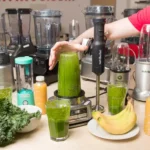The best way to remove tough stains from a blender is to fill it with hot water and a few drops of dish soap, then run it on high speed for a few seconds. This will loosen up the stains and make them easier to rinse off. Alternatively, you can use vinegar, baking soda, or lemon juice to clean your blender naturally.
Blenders are great kitchen appliances that can help you make smoothies, soups, sauces, and more. However, they can also get stained by some ingredients, such as berries, turmeric, coffee, or tomato sauce. These stains can make your blender look dirty and unappealing, and may even affect the taste and smell of your food.
Fortunately, there are some simple and effective ways to remove tough stains from your blender without using harsh chemicals or scrubbing too hard. In this article, we will show you how to clean your blender with common household items and some tips to prevent stains in the future.
How to clean your blender with dish soap and hot water
One of the easiest and most convenient ways to clean your blender is to use dish soap and hot water. Here are the steps to follow:
- Rinse your blender with warm water to remove any loose debris.
- Fill your blender halfway with hot water and add a few drops of dish soap. You can also add a splash of white vinegar for extra cleaning power.
- Put the lid on your blender and run it on high speed for 10 to 15 seconds. This will create a sudsy mixture that will reach all the corners and crevices of your blender.
- Pour out the dirty water and rinse your blender with clean water. Repeat the process if needed until the stains are gone.
- Dry your blender with a soft cloth or let it air dry.
How to clean your blender with vinegar, baking soda, or lemon juice
If you prefer to use natural cleaners, you can also use vinegar, baking soda, or lemon juice to remove tough stains from your blender. These ingredients have acidic or alkaline properties that can break down the stains and disinfect your blender. Here are the steps to follow:
- Rinse your blender with warm water to remove any loose debris.
- Choose one of the following options:
- Fill your blender halfway with white vinegar and add some water to dilute it. You can also add a few drops of dish soap for extra cleaning power.
- Sprinkle some baking soda on the stained areas of your blender and add some water to make a paste. You can also add some vinegar to create a fizzing reaction that will lift the stains.
- Squeeze some lemon juice on the stained areas of your blender and add some water to make a solution. You can also add some salt to create a gentle abrasive that will scrub the stains.
- Put the lid on your blender and run it on high speed for 10 to 15 seconds. This will create a bubbling or foaming mixture that will reach all the corners and crevices of your blender.
- Pour out the dirty water and rinse your blender with clean water. Repeat the process if needed until the stains are gone.
- Dry your blender with a soft cloth or let it air dry.
How to prevent stains on your blender
The best way to prevent stains on your blender is to clean it as soon as possible after each use. This will prevent the stains from setting in and becoming harder to remove. Here are some tips to keep your blender stain-free:
- Rinse your blender with warm water immediately after using it. This will remove any residue that may cause stains.
- If you can’t clean your blender right away, fill it with water and a few drops of dish soap and let it soak until you are ready to clean it. This will prevent the stains from drying and sticking to your blender.
- Avoid using abrasive cleaners or scouring pads that may scratch or damage your blender. This will make it more prone to stains and bacteria growth.
- Store your blender in a cool and dry place away from direct sunlight. This will prevent the stains from fading or discoloring your blender.
Conclusion
Cleaning your blender is not a difficult task if you know how to do it properly. By using dish soap, hot water, vinegar, baking soda, or lemon juice, you can remove tough stains from your blender and make it look like new. Remember to clean your blender as soon as possible after each use and avoid using harsh chemicals or scrubbers that may harm your blender. By following these tips, you can enjoy your blender for a long time and make delicious recipes with it.




